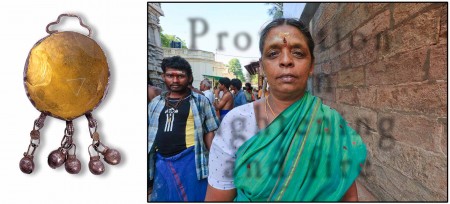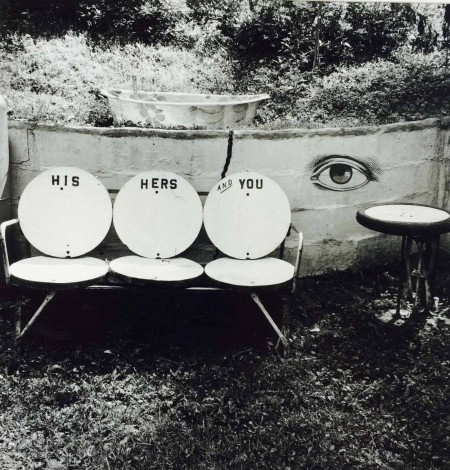Foto Founders at Covington’s Behringer-Crawford Museum provided an interesting element in the flurry of Foto Focus exhibitions during its October run. Who were primary influences on many of today’s practicing photographers in the Cincinnati region? Five professors at three area academic institutions were spotlighted, with five to six works by each, usually including both color and black and white and representing both early and later work by these tireless lens-based artists.
Two of the photographers, Jerry Stratton and Jane Alden Stevens, taught at the University of Cincinnati; two others, Barbara Houghton and Barry Andersen, at Northern Kentucky University, and Cal Kowal was a faculty member at the Art Academy of Cincinnati for many years. Throughout their careers interest in photography has only heightened and its stature as an art form has solidified.
Curator Diane Kruer, asked to comment on the multitudinous changes in photography during the teaching careers of these photographers, replied by email that she preferred the artists themselves respond to those questions and added “These five have given their hearts and minds to the photo community. . .I think they have the best overview of changes in the medium.”
Andersen, noting that his formal photography education took place from 1970 to 1975, reported training in traditional gelatin silver black and white photography; the course of his career has seen development of color, of digital photography, of conceptual photography. Transitions were often difficult, he says, “with hardware lagging behind the potential of cameras and software.”
Andersen showed work ranging over his many years of practicing photography, playing with his subject matter – these works are not intended to be documents, his exhibition statement pointed out – from the early 1980s to this year. All are archival ink jet prints, the two earliest in black and white. Who needs color for a parched and cracked landscape? Each of these is named for the state in which it was taken, Florida and Indiana. Two others, in color, apparently shot from an airplane, are also named for states (Kentucky, Alabama). This is interesting as both have lost identity as landscape in becoming abstract works of art. Andersen is intensely interested in the relationships and contrasts of forms – a curvy flock of sheep appears with the very regular lines of a stone pyramid off to the right behind them in one photograph. His works can, somewhat, talk to one another: “Salt Flat Pool,” taken in Camargue, France, in 2013 was nicely paired with a work from Iceland (2016) showing a landscape of water, stones and sky. As it happened, the Iceland photograph was only a few days old when the show opened, so the time span of his work was widely represented. Andersen has worked, over the years, with a 4×5 view camera, a Pentax 6×7 film camera, and a variety of digital “DSLRs.”
Stratton showed six relatively recent works (2014-16), ink jet on paper, that see the streets as subject, the people using them shadowed, looking away, not individualized, and the shape of his photographs – the height and width – adjusted to subject matter. He says, of the rapidly evolving medium, “Films got faster, sharper in both monochrome materials and then along came color. . .in the last couple of decades of the 20th century digital began its own evolution. Then there were sociological changes. Equipment and materials were, in the beginning, expensive and the processes time consuming and required skill.” This altered to produce “snapshots, family albums and pictures to illustrate things and places in a way not seen before, all requiring less money and much less skill.” He adds wryly “Is photography an Art became a huge question and provoked many an argument.”
Houghton says “I loved the challenge of learning new things, playing with new tools, seeing new approaches, telling stories, and building things. I was in the right place at the right time surrounded by the right people.” Her four color prints shared a theme, that of need for protection, and each was shown with an amulet to protect mounted within the frame along with the photograph itself. The individual danger shown is spelled out in see-through letters over each print: lightening and fire, snake bite, scorpions, evil spirits, storms. These works are touched with mystery and trigger the viewer into thinking of personal fears and dangers.
I wasn’t able to reach the other two participants in the exhibition for comment, but their works speak for themselves in many ways.
Kowal’s five images were the first encountered by visitors to the exhibition, with two relatively recent (2000) large color images from a series called “Past Your Eyes” and three vintage black and white silver gelatin prints, a historic process. Kowal is interested in shapes, their contrasts and echoing, in whatever means he uses.
Stevens also was represented by five works, all from her 1981 thesis project called “Dancing on a Wall.” For these photographs she was using methods “out of my comfort zone,” her statement explained. The subject is less important than the formal result in these mysterious black and white photographs printed on photo aluminum.
During this period photography became an ever more important segment of the art world. This highly personal show suggested rather than defined the era and was limited in that five long careers were represented in one relatively small gallery. The artists surely were aware of each others’ work; the curator of the exhibition is the wife of one of the photographers. Reflecting increased interest in photography as an art form, a new photo discussion group is scheduled to meet for the first time on Friday, November 18, at Pendleton Art Center, 1310 Pendleton Street in Over-the-Rhine, 7-9 p.m.



